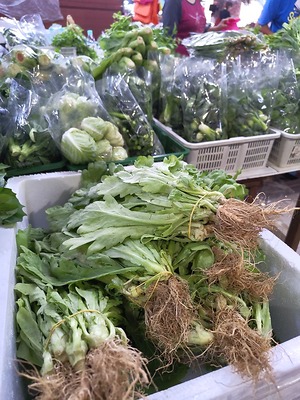


Chrysanthemum Garland Leaves
Estimated Inventory, lb : 0
Description/Taste
Garland Chrysanthemum leaves are elongated, obovate leaves. They grow from firm, slender stems and have rounded tips. They grow to up to 20 centimeters in length. They have a very mild, herbaceous scent and a crisp texture. Their flavor is milder than the regular type of Chrysanthemum leaf, but are still tangy and mustardy with hint of floral sweetness. They become sharper in taste with age, so it is best to eat them when they are young. They are also best harvested before the plant flowers. They have a crisp texture.
Seasons/Availability
Garland Chrysanthemum leaves are available year-round.
Current Facts
Chrysanthemum Garland leaves are botanically classified as Chrysanthemum coronarium. Some varieties of the Chrysanthemum Garland include the Tiger Ear Chrysanthemum, Small Leaf Chrysanthemum, and Round Leaf Chrysanthemum. The Chinese sometimes refer to Garland Chrysanthemum leaves as Crown Daisy leaves. Chrysanthemum Garland leaves are easily distinguished from the regular variety of Chrysanthemum leaves, as they are broader and less incised.
Nutritional Value
Garland Chrysanthemum leaves are high in potassium. One serving may contain 30% more potassium than bananas. Garland Chrysanthemum leaves also contain vitamin A, vitamin B, vitamin C, calcium, iron, carotene and flavanoids.
Applications
Garland Chrysanthemum leaves may be used raw, in salads. They are also a popular potherb. In China, they can be found in chicken broth. They are also commonly found in sautees, combined with other vegetables such as bamboo shoots, snow peas and bean sprouts. Or, cook them along with spinach, beet greens, or Swiss chard. They are good hot or cold as a side dish for chicken or pork dishes. Cook them with some sesame oil, soy sauce and a dash of sherry. Take care not to overcook the leaves, as they will develop a bitter taste. Store Chrysanthemum Garland leaves in a loose bag in the refrigerator. Use them as soon as possible, as they will wilt after two days.
Ethnic/Cultural Info
Chrysanthemums are revered in the cultures of China and Japan. In China, they are a symbol of late-blooming beauty. In Japan, where it is the national flower, the flowers are served as part of Japanese tea ceremonies.
Geography/History
All Chrysanthemum leaves are native to east Asia. Chrysanthemum Garland leaves were widely developed in China. By the time of the Song Dynasty (960 to 1279 CE), there were said to be some 35 varieties. Today, there are more than 3,000 varieties. Chrysanthemum Garland leaves are extremely popular as a vegetable. It is seen regularly in supermarkets and local markets in South-East Asia.
Recipe Ideas
Recipes that include Chrysanthemum Garland Leaves. One








